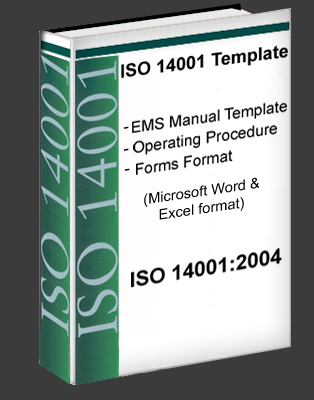Ems Iso 14001 Manual Template


ISO EMS Manual Template. EMS Manual is based on Plan-Do-Check-Act model and references the following ISO 14000 family standards. The document is easily editable in MS Word. Generic ISO 14001 EMS Templates User Manual Contents September 2005 Page i Rev- d5 Contents of this User Manual. PLAN CHECK DO ACT ISO 14001.
Example EMS Manual - ISO 14001 • 1.
ISO 14000 is a family of standards related to that exists to help organizations (a) minimize how their operations (processes, etc.) negatively (i.e., cause adverse changes to air, water, or land); (b) comply with applicable laws, regulations, and other environmentally oriented requirements; and (c) continually improve in the above. 14000 is similar to in that both pertain to the process of how a product is produced, rather than to the product itself. As with ISO 9001, certification is performed by third-party organizations rather than being awarded by ISO directly. The and audit standards apply when audits are being performed.
The requirements of ISO 14001 are an integral part of the 's (EMAS). EMAS's structure and material requirements are more demanding, mainly concerning performance improvement, legal compliance, and reporting duties. The current version of ISO 14001 is ISO, which was published in September 2015. See also: In March 1992, published the world's first environmental management systems standard, BS 7750, as part of a response to growing concerns about protecting the environment. Prior to this, environmental management had been part of larger systems such as.
BS 7750 supplied the template for the development of the ISO 14000 series in 1996, which has representation from ISO committees all over the world. As of 2017, more than 300,000 certifications to ISO 14001 can be found in 171 countries. Prior to the development of the ISO 14000 series, organizations voluntarily constructed their own EMSs, but this made comparisons of environmental effects between companies difficult; therefore, the universal ISO 14000 series was developed.
An EMS is defined by ISO as: 'part of the overall management system, that includes organizational structure, planning activities, responsibilities, practices, procedures, processes, and resources for developing, implementing, achieving, and maintaining the environmental policy.' Development of the ISO 14000 series [ ] The ISO 14000 family includes most notably the ISO 14001 standard, which represents the core set of standards used by organizations for designing and implementing an effective (EMS). Other standards in this series include ISO 14004, which gives additional guidelines for a good EMS, and more specialized standards dealing with specific aspects of environmental management. The major objective of the ISO 14000 series of norms is to provide 'practical tools for companies and organizations of all kinds looking to manage their environmental responsibilities.' Mp4 Telugu Video Songs Free Download Latest.
The ISO 14000 series is based on a voluntary approach to environmental regulation. The series includes the ISO 14001 standard, which provides guidelines for the establishment or improvement of an EMS. The standard shares many common traits with its predecessor, ISO 9000, the international standard of quality management, which served as a model for its internal structure, and both can be implemented side by side. Free Download Font Ttf Unicode S60v3. As with ISO 9000, ISO 14000 acts both as an internal management tool and as a way of demonstrating a company’s environmental commitment to its customers and clients.
ISO 14001 standard [ ] ISO 14001 defines criteria for an EMS. It does not state requirements for environmental performance but rather maps out a framework that a company or organization can follow to set up an effective EMS. It can be used by any organization that wants to improve resource efficiency, reduce waste, and reduce costs.
Using ISO 14001 can provide assurance to company management and employees as well as external stakeholders that environmental impact is being measured and improved. ISO 14001 can also be integrated with other management functions and assists companies in meeting their environmental and economic goals. ISO 14001, like other ISO 14000 standards, is voluntary, with its main aim to assist companies in continually improving their environmental performance and complying with any applicable legislation. Prestigio Geovision 7777 Руководство here.
The organization sets its own targets and performance measures, and the standard highlights what an organization needs to do to meet those goals, and to monitor and measure the situation. The standard does not focus on measures and goals of environmental performance, but of the organization. The standard can be applied to a variety of levels in the business, from the organizational level down to the product and service level. ISO 14001 is known as a generic management system standard, meaning that it is relevant to any organization seeking to improve and manage resources more effectively. This includes: • single-site to large multi-national companies • high-risk companies to low-risk service organizations • the manufacturing, process, and service industries, including local governments • all industry sectors, including public and private sectors • original equipment manufacturers and their suppliers All standards are periodically reviewed by ISO to ensure they still meet market requirements. The current version is ISO, and certified organizations were given a three-year transition period to adapt their environmental management system to the new edition of the standard. The new version of ISO 14001 focuses on the improvement of environmental performance rather than the improvement of the management system itself.